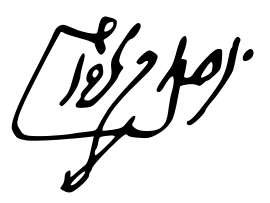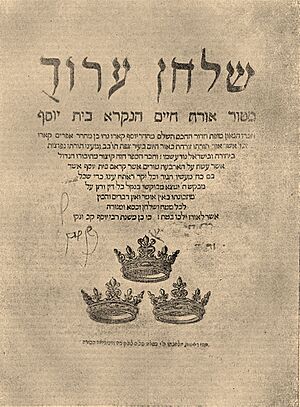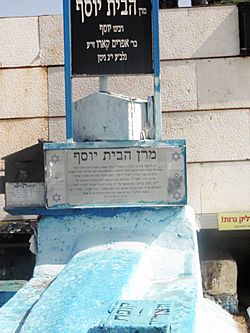Joseph Karo facts for kids
Quick facts for kids Joseph Karo |
|
|---|---|

Artistic conception of Karo's appearance. Painting of 19th century
|
|
| Religion | Judaism |
| Personal | |
| Born | Joseph ben Ephraim Karo 1488 Toledo, Kingdom of Toledo, Crown of Castile |
| Died | March 24, 1575 Safed, Damascus Eyalet, Ottoman Empire |
| Senior posting | |
| Title | הַמְחַבֵּר HaMechaber מָרַן Maran |
| Signature |  |
| Buried | Safed, Israel |
Joseph ben Ephraim Karo, also known as Yosef Caro or Qaro (Hebrew: יוסף קארו; 1488 – March 24, 1575), was a very important Jewish leader and scholar. He is famous for writing the Shulchan Aruch, which is a major book of Jewish law. Because of this, he is often called HaMechaber (Hebrew: הַמְחַבֵּר, "The Author") and Maran (Imperial Aramaic: מָרַן, "Our Master").
Contents
Who Was Rabbi Joseph Karo?
Joseph Karo was born in Toledo, Spain, in 1488. When he was just four years old, his family, like many other Jewish families, was forced to leave Spain in 1492. This happened because of a special order called the Alhambra Decree.
Early Life and Journeys
After leaving Spain, Joseph Karo and his family moved to Portugal. But they were forced to leave Portugal too in 1497. The Ottoman Empire, which was a large and powerful empire at the time, welcomed Jewish people. So, Karo and his family moved there, first to Morocco, and then to a city called Nikopolis.
In Nikopolis, Joseph Karo learned from his father, who was a very wise teacher of Jewish law. Joseph Karo was married twice. Both of his wives were daughters of well-known Jewish scholars.
Between 1520 and 1522, Karo lived in a city called Adrianople. Later, around 1535, he moved to Safed in Ottoman Galilee. On his way to Safed, he spent several years in Salonica and Istanbul. By 1555, he was living near Safed and finished writing the first part of his famous book, the Shulchan Aruch.
Becoming a Great Rabbi
Joseph Karo wanted to live in the Land of Israel to feel closer to its holiness and finish his important writings. He traveled through Salonica, where he met a great teacher of Kabbalah, a mystical part of Jewish tradition, named Joseph Taitazak. He continued his journey through Egypt and finally settled in Safed.
In Safed, he met another important rabbi, Jacob Berab. Karo soon became a member of Berab's rabbinical court. A rabbinical court is like a special court where rabbis make decisions about Jewish law. Berab had a big idea to bring back semicha, which is a special ordination or permission for rabbis to teach and make legal decisions. This tradition had not been used for over 1,100 years.
Karo strongly supported Berab's plan. He was one of the first rabbis to receive this special ordination from Berab. After Berab passed away, Karo tried to continue this tradition by ordaining his own student, Moshe Alshich. However, he eventually realized it was too difficult to overcome the disagreements about bringing back semicha.
Karo also started a yeshiva, which is a school for studying Jewish texts. He taught more than 200 students there.
Leading the Safed Court
When Jacob Berab died, Joseph Karo was seen as his natural successor. He led the Rabbinical Court of Safed along with Rabbi Moshe of Trani. This court in Safed became the most important rabbinical court for Jewish communities in the region and even around the world.
People from all over would ask the Safed court for advice and decisions on important matters. Karo's decisions on Jewish law were accepted as final. Even great scholars from Egypt, like Rabbi David ben Solomon ibn Abi Zimra and Rabbi Yaakov de Castro, visited him in Safed. He was seen as the leader of his entire generation.
His Heavenly Guide
Rabbi Shlomo Halevi Alkabetz, another scholar, shared an amazing story. He said that in Salonica, Joseph Karo was one of the rare people who had a maggid. A maggid was like a private angelic teacher who would visit him and share many secrets of Kabbalah.
This maggid encouraged Karo to be very holy and pure. It even told him about things that would happen in the future. The teachings from this maggid are written in Karo's book called Maggid Meisharim. Some people believe the maggid was the Oral Torah itself, speaking through Karo.
The maggid promised Karo that he would get to live in the Land of Israel, and this promise came true. Another promise, that he would die a martyr's death (dying for his faith), did not happen for a reason that is not known.
For the last thirty years of his life, Joseph Karo was one of the most respected rabbis, almost as famous as Maimonides from long ago. Even scholars who disagreed with him, like Azariah dei Rossi from Italy, helped raise money to print Karo's books. His influence was felt far and wide. For example, when some people in France felt they were treated unfairly with taxes, they wrote to Karo. His letter was enough to help them get their rights back.
His Important Books
Joseph Karo's books are considered masterpieces of Jewish religious writing. He published several important works during his lifetime:
- Beit Yosef (בית יוסף): This was a huge commentary on an earlier book of Jewish law called Arba'ah Turim. In this book, Karo showed his amazing knowledge of the Talmud (a central text of Jewish law) and other legal writings. He wanted to organize Jewish laws and customs, especially after the Jewish people were forced to leave Spain.
- Shulchan Aruch (שולחן ערוך): This is a shorter, easier-to-understand version of his decisions from Beit Yosef. He finished this code in 1555, and it was published in four parts in 1565. It became the most widely accepted code of Jewish law.
- Kessef Mishneh (כסף משנה): Written around 1574–75, this book is a commentary on Mishneh Torah by Maimonides. Karo's goal was to show where each law in Mishneh Torah came from and to defend it from criticisms.
After his death, other works of his were published:
- Bedek ha-Bayit (בדק הבית): These were additions and corrections to Beit Yosef.
- Kelalei ha-Talmud (כללי התלמוד): This book explained how to understand the Talmud.
- Avkath Rochel (אבקת רוכל): This book contained his Responsa, which are his answers to questions about Jewish law.
- Maggid Meisharim (מגיד מישרים): This book recorded his mystical experiences.
- Derashot (דרשות): These were his speeches.
The Shulchan Aruch

The Shulchan Aruch is Joseph Karo's most famous work. Its name means "Set Table" in Hebrew. It is a clear and organized guide to Jewish law. This book became the standard for Jewish practice around the world. It helped Jewish communities, who were spread out after being expelled from Spain and Portugal, to follow the same laws and customs.
Maggid Meisharim Explained
The Maggid Meisharim (published in 1646) is like a spiritual diary. In it, Karo wrote about visits from an angelic being over fifty years. This heavenly guide, who was said to be the personified Mishnah (a collection of Jewish Oral Law), encouraged him to do good deeds and live a holy life. It also urged him to study Kabbalah and sometimes corrected him for small mistakes.
Where is He Buried?
Joseph Karo is buried in the Old Cemetery of Tzfat / Safed in Israel.
Other important rabbis also buried in the Old Cemetery of Tzfat / Safed include:
- Ari HaKadosh
- Alshich Hakadosh
- Shlomo Halevi Alkabetz
- Moses ben Jacob Cordovero
See Also
 In Spanish: Joseph Caro para niños
In Spanish: Joseph Caro para niños



